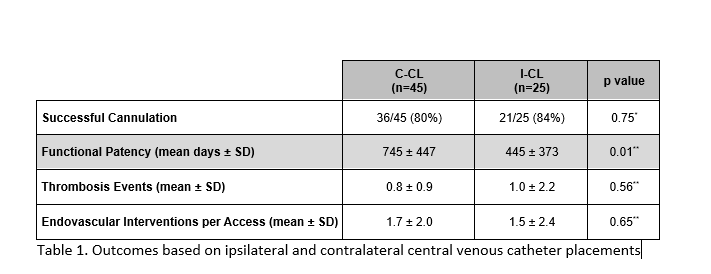Central Line Access For Hemodialysis Adversely Affects Ipsilateral Arteriovenous Graft Outcomes
Diana Otoya, MD, Kedar S. Lavingia, MD, Marc Posner, MD, Michael Amendola, MD, MEHP.
Virginia Commonwealth Univsersity, Richmond, VA, USA.
OBJECTIVES: Current national guidelines recommend if central catheter is needed for dialysis treatment, contralateral placement placements should be favored over an ipsilateral position. Previous venogram studies have demonstrated a central venous stenosis incidence of about fifty percent in patients with central access. We set forth to delineate any clinically significant outcomes in patients with an ipsilateral or contra lateral central catheter for dialysis treatments at the time of arteriovenous graft (AVG) placement.
METHODS: A Veterans Administration Hospital dialysis access database from January 1, 2006 to January 1, 2018 to identify all patients who had upper extremity AVG placement with an ipsilateral (I-CL) or contralateral (C-CL) central line for hemodialysis. Factors examined included: successful cannulation, functional patency (successful needle cannulation and usage on dialysis), thrombosis events and endovascular interventions per access. We also examined previous access procedures and patient demographics. We followed all outcomes until April 1, 2019. Studentís t-test** and Fisherís Exact test* were utilized.
RESULTS: A total of 70 AVG were placed in 70 male patients (71.4% of all AVG patients during the same time period). Twenty-five patients had ipsilateral central catheters at the time of AVG creation (TABLE 1). 
Factors not found to be different between the two groups included hypertension, smoking history, platelet, BUN, hemoglobin, antiplatelet prescription, previous arteriovenous access, BMI, glucose, creatinine, hemoglobin, MCV, platelet, race, mortality nor smoking history. I-CL had a statistically significant higher rate of anticoagulation use (32% vs. 4.4%; p=0.003*) compared to C-CL respectively.
CONCLUSIONS:
In following patients with and without ipsilateral central line placement, there was a statistically significant drop in functional patency without a difference in cannulation rate, thrombosis events nor overall endovascular interventions. Interestingly, almost a third of the I-CL patients were on an anticoagulation medical regimen. It is not clear what effect these factors contribute to decreased AVG patency rates and warrants further future study.
Back to 2021 Karmody Posters
